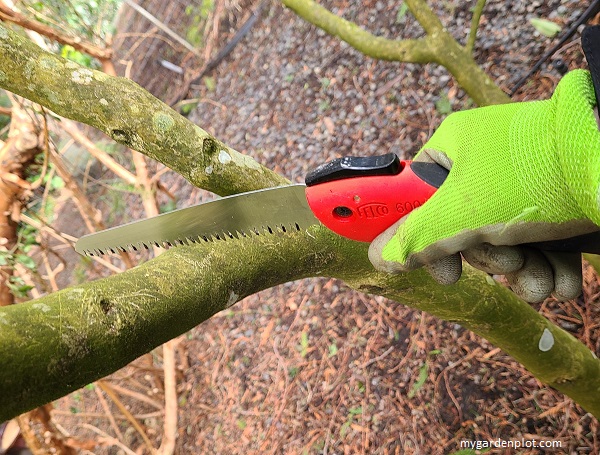Buyer's Guide
How To Choose A Pruning Saw (Garden Hand Saw)
For the garden, there are specific pruning saws for shrubs and trees. Please don’t be tempted to use a carpenter hand saw for pruning your shrubs and trees in your garden. This will damage your plant and potentially increase the risk of disease and decay. This buyer’s guide will point out what you need to know about garden hand saws, how to choose the best pruning saw for your garden, why you should consider blades with impulse hardened teeth and pruning saw safety tips.
Pruning saws are an essential garden tool designed to cut thicker stems and branches. While pruning saws can cut branches up to 25 cm (10 inches), most gardeners use them for stems and branches in the range of 10-15 cm (4-6 inches) in diameter. More than 15 cm (6 inches) becomes a good workout, at least for me, and perhaps you may want to consider a chainsaw at that point. Having a sturdy saw in your pruning kit will make your tasks easier for removing those thicker branches and stems. There are various kinds – saws with fixed (stationary) blades, folding types and extended poles for cutting green wood and deadwood. These pruning saws are wickedly sharp. And as with any pruning, a sharp blade will provide a smooth, clean-cut and ensure the shrub or tree heals quickly and reduce the risk of disease. Serious gardeners and arborists use pruning saws with impulse hardened teeth. More about this blade technology below.
Pruning Saw Action
Pull Stroke vs Push Stroke
Hands saws can cut in both directions or push stroke, but most pruning saws cut on the pull stroke. A pull stroke action has more power. The blade can be thinner and thus keeps straighter and give a smooth, clean cut with less effort and damage to the stem or branch. A hand saw with a push stroke needs a little more human power, has a thicker blade and can twist when cutting.
Cutting Teeth Geometry
The quality of the blade and the geometry of the teeth also play a significant role in the cutting capacity. Many of the pruning saws have triple ground teeth offering a more efficient, sharper and smoother cut over the double ground teeth of traditional saws. High-quality pruning saws design blade and teeth geometry to eliminate clogging and sap and tree resin build-up when cutting green wood.
What Is Impulse Hardening?
You will often read about pruning saws having impulse hardened teeth. But why should you be interested in this type of blade engineering? Impulse hardening is a unique heating technique applied to the blade’s teeth, making them harder and remarkably sharp and for longer. The remainder of the blade is not put through the impulse hardening process to maintain its normal flexibility to deliver high cutting performance. Impulse hardened teeth remain sharp about three times longer than non-impulse hardened saws. Depending on your pruning needs, this may be a factor in your decision when buying a pruning saw. Due to the process taken with impulse hardened teeth, it is best to replace a blade than to sharpen it. These high quality pruning saws tend to be more expensive but surprisingly not too much more.
Straight Edge Pruning Saw and Japanese Pruning Saws
Straight edge saws are the go-to for most pruning tasks needing the power of a hand saw. The traditional Japanese pruning saw is a highly admired garden tool. Pruning saws readily available today offer many of the same traditional benefits with the added cutting power of impulse hardened teeth. What you should look for in a pruning saw, is a sturdy blade that is flexible, yet resistant to buckling. These sharp pruning saws have a straight edge with an ergonomically curved handle that cut on the pull stroke. They are at their best when pruning stems and branches that are in line from your mid-body and shoulder height. Its effectiveness is due to your arm position and your body’s movement relative to where you are cutting. However, they are perfectly suited for most pruning scenarios with thick stems and branches. If you can only purchase one type of pruning saw, go with a straight edge blade.
Curved Bladed Pruning Saw and Grecian Saws
Curved bladed saws and Grecian saws have, as the name implies, a curved blade. Besides the pull stroke action, this shape makes it a handy tool for removing stems or branches growing close together as it fits more easily into tight spots. The sharp curved blade also helps to conform to the natural body movement while reaching up and sawing, while giving a clean power cut with less effort. Gardeners with more extensive gardens and many shrubs and trees are likely to include a curved pruning saw along with a straight edge saw in their pruning kit.
Folding Pruning Saws
The folding pruning saw is the most practical as they are easy to carry around. Both straight and curved blades are available as folding saws. It basically folds safely into its handle similar to a switchblade. If you do occasional pruning and want to have just one pruning saw in your kit, I recommend going for a straight edge folding pruning saw
Pole Pruning Saws
The pole pruning saw is effectively a saw at the end of a long pole to cut out-of-reach branches that are no more than 5 cm (2 inches) in diameter. With safety in mind, they are meant to be used without a ladder. Both straight and curved blades are available with pole saws.
SEE MORE: Scroll to the end of the page for information about safety tips when using a pruning saw in the garden.
Recommendations: Best Pruning Saws
Our Top Pick
ARS SA-CAM24PRO Professional Arborist Saw 10-inch Straight Blade
The ARS SA-CAM24PRO Professional Arborist Saw has impulse hardened teeth staying extremely sharp longer. It is one our favourite pruning saws. Made of high carbon steel and hard-chrome plated blade. It is a compact size, and its powerfully sharp blade leaves a very clean cut with little effort on a pull stroke. It is an impressive pruning saw and our top pick. The reversible sheath is included and can be safely strapped to a belt or leg. Blades are replaceable.
Felco 611 Pruning Saw 13-Inch Straight Blade
The Felco 611 Straight Blade Pruning Saw is made from hardened steel and chrome-plated stainless blade and has impulse hardened teeth. It cuts on a pull stroke and has a comfortable ergonomic handle well balanced with the blade for a smooth and effortless clean cut. It is generally more expensive than the ARS Pro 10 inch, but like the ARS, the Felco 611 pruning saw is impressive, durable and long-lasting. Worth it if you are looking for a longer blade length to give you that extra reach. The sheath has a belt loop. All parts, including the blade, are replaceable if necessary.
Top Folding Choice
ARS SA-210DX Turbocut Straight Blade Folding Saw
The ARS SA-210DX Turbocut Straight Blade Folding Pruning Saw is a sturdy, compact pruning saw that easily fits into a pocket when folded. Its small size 5.75-inch blade is no reflection on its cutting capacity. Power cut on a pull stroke with little effort delivers on its Turbocut action and heavy-duty use through thick branches. The hard-chrome plated blade is replaceable.
Felco F600 Straight Blade Folding Pruning Saw
Along with the ARS folding saw is the popular Felco F600 Straight Blade Folding Saw with 6.3 inch blade. This handy compact folding saw has a strong power cut on a pull stroke. As with most products from the Felco brand, it delivers with high performance with impulse hardened teeth. The hard-chrome plated blade is replaceable, and when folded, it is very portable. This is an excellent folding pruning saw. However, I do find I needed to clean it a little more often when there is sap from the stem.
Top Curved Choice
ARS SA-GR17 Pruning Folding Curved 6.5-Inch Blade Turbocut Saw
The ARS SA-GR17 Pruning Folding Turbocut Saw with a curved blade is ideal for removing stems growing close together, especially at the base of a congested shrub. Incredibly sharp, leaving a clean cut. It is lightweight, and with a 6.5 inch blade, it can fit into a pocket when folded. Made of high carbon steel and hard-chrome plated. Blades are replaceable. It is worth the price for dedicated pruning.
Corona RS16020 Curved Blade Razor Tooth Pruning Saw 14-Inch Blade
The Corona RS16020 Curved Blade Razor Tooth Pruning Saw is ably named. It is impressively faster with cutting with the three-sided impulse hardened teeth along with the longer curved blade design; it is perfect for larger branches. The blade is replaceable. This power cut, along with the affordable price point, makes it a winner. Unfortunately, it does not come with a guard.
Handy Option
Fiskars 8 Foot Compact Extending Tree Pruning Saw
The Fiskars 8 Foot Pole Pruning Compact Extending Tree Pruner Saw is meant to be used without using a ladder for that extra reach. It conveniently collapses into a compact 3’ and can extend up to 8’. The curved blade with triple ground teeth can cut a branch up to 3-4” in diameter.
Pruning Saw Safety Tips
Pruning saws are very sharp, and care must always be applied. It is not recommended that you climb a tree for pruning. Use a ladder carefully, and consider whether to call a professional or arborist for pruning large trees and heavy branches. Use tough anti-slip gloves and eye protection such as goggles. If pruning overhead wearing a safety helmet to protect your head from branches that fall accidentally, especially when using a pole pruning saw.
RELATED TOPIC: Buyer’s Guide How To Choose Garden Hand Pruners (Secateurs)






